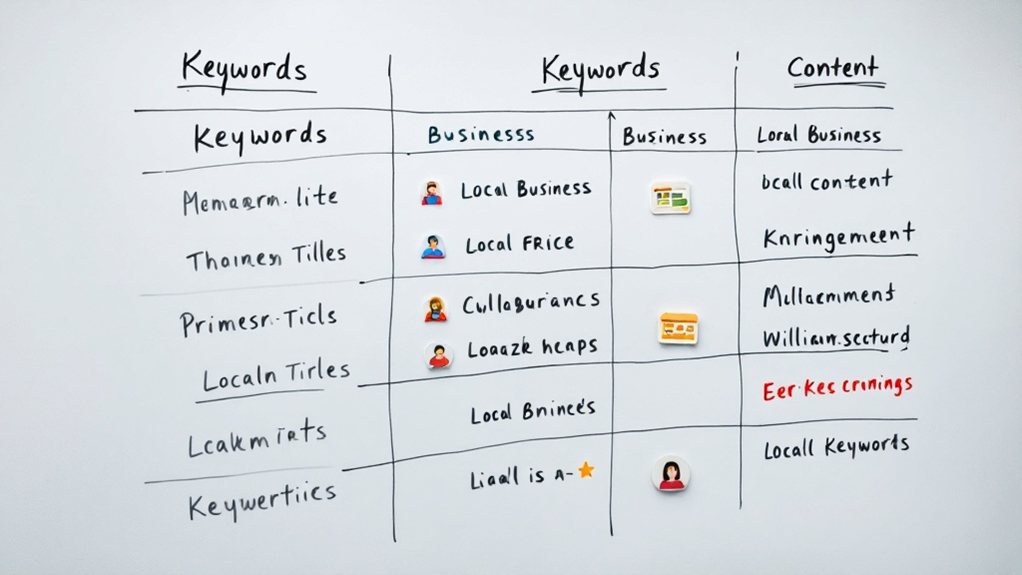To prioritize keywords for your local business content, start by identifying relevant seed phrases based on your core offerings and location. Analyze metrics like search volume, competition, and conversion potential to narrow down the most impactful keywords. Align them with your marketing goals, whether that's driving sales or generating leads. Utilize keyword research tools to uncover location-specific insights and leverage competitor data. By strategically prioritizing local keywords, you can create content that resonates with your target audience and boosts your online visibility. Explore further to dive deeper into effective local keyword strategies.
Identifying Relevant Local Keywords

How do you identify the most relevant local keywords for your business content? Start by determining your core business type to generate a list of generic seed phrases like "bakery" or "divorce lawyer." Include service categories and general terms to capture diverse search intent. Then, brainstorm location modifiers by using city names, neighborhoods, landmarks, and even ZIP codes. Leverage keyword research tools like Google Keyword Planner and Semrush to analyze search volume and identify opportunities. Structure your local keywords by combining business and location, adding specific services, and incorporating user intent or pricing details. This strategic approach ensures your content targets the most relevant local searches. By prioritizing these local keywords, you can improve the visibility and performance of your business in search engine results.
Analyzing Keyword Metrics

When prioritizing keywords for your local business content, you'll want to analyze search volume and competition. This will help you understand the potential visibility and conversion opportunities. Evaluating the cost-per-click and keyword difficulty can further inform your content strategy and resource allocation.
Search Volume and Competition
Understanding the search volume and competition surrounding local business keywords is crucial for effective content prioritization. High search volume indicates strong interest, driving local traffic, while low volume might signal niche opportunities. Competitor analysis reveals who targets specific keywords, informing your strategy to outperform rivals. High competition means ranking challenges, but low competition keywords may have lower search volumes. Cost-per-click (CPC) reflects keyword value, guiding advertising budget planning. Evaluating keyword difficulty helps focus on achievable rankings. By balancing search volume, competition, CPC, and keyword difficulty, you can make informed decisions to prioritize the most impactful local keywords for your business content. Staying up-to-date on changes in local search trends can further optimize your keyword strategy.
Conversion Potential Analysis
Analyzing the conversion potential of keywords is essential for prioritizing local business content. Focus on terms that closely align with your products or services, indicate specific customer intent like "best" or "affordable," and incorporate geographic modifiers. Additionally, target long-tail keywords with higher conversion potential due to their specificity, and use flexible keywords that adapt to various content formats and marketing channels. Carefully consider the monthly search volume of keywords to ensure you are targeting terms with sufficient demand.
To refine your keyword selection, leverage tools like:
- Google Keyword Planner
- SEMrush Keyword Magic Tool
- Ahrefs
- Moz Keyword Explorer
Continuously optimize your keywords by monitoring user engagement, conversion rates, and local trends to ensure maximum impact.
Prioritizing Keywords Based on Goals

Effectively prioritizing keywords for your local business content begins by aligning them with your key objectives. Focus on terms that directly relate to desired outcomes like increased sales or leads. Prioritize conversion-oriented queries that reflect a customer's ready-to-purchase mindset. Consider the relevance and search volume of keywords, balancing popularity with manageable competition. Incorporate geographic modifiers to target local searches, and optimize content by placing primary keywords in titles and descriptions. Throughout, ensure your keywords match your unique selling proposition and address specific stages of the buyer's journey. This strategic approach will help drive the most valuable traffic to your local business. [Mapping location-specific keywords to individual location pages can further enhance your local SEO strategy.
Using Tools for Keyword Research
With your objectives in mind, exploring the various tools available for local keyword research can prove invaluable. Tools like KWFinder and Moz Keyword Explorer offer location-specific insights, including search volumes and SERP analysis. Leveraging features like competitor analysis and keyword clustering can uncover overlooked opportunities to outrank local competitors. When selecting tools, consider the following criteria:
- Cost: Free options like Google Keyword Planner provide a budget-friendly starting point.
- Ease of use: Prioritize user-friendly interfaces for efficient research.
- Data precision: Accurate search volume metrics can inform strategic decisions.
- Long-tail generation: Essential for targeting specific local search queries.
Integrating these tools into your content strategy can help you identify the most impactful keywords to attract your local audience. [Utilizing location-specific keyword research can provide deeper insights into your target market's search behavior.
Structuring Local Keywords for Effectiveness
How can you structure local keywords effectively for your business content? Leverage core terms like "bakery" and pair them with modifiers like "French" and locations like "Paris" to create focused keywords. Incorporate implicit and explicit terms to broaden your reach. Experiment with keyword variations, such as "Glasgow hairdresser" or "hairdresser Glasgow," to improve visibility. Ensure your business name serves as a core term when relevant. Utilize long-tail keywords as they can be more specific and less competitive. Prioritize high-volume, low-difficulty keywords for optimal impact. Strategically place local keywords in titles, meta descriptions, and content for better optimization. Monitor competitor strategies to uncover untapped opportunities and adjust your approach based on evolving search trends.
Maintaining a Dynamic Keyword Strategy
Continuously tracking your keyword performance is crucial. Be ready to pivot your strategy as consumer search trends evolve. Leverage tools to stay on top of shifting keyword opportunities and maintain a competitive edge. Conducting keyword research is an ongoing process that requires regular monitoring and adjustment to ensure your content remains relevant and visible.
Continuous Keyword Monitoring
Effective local SEO hinges on your ability to continuously monitor and adapt your keyword strategy. Tracking rankings, search volume, and competitor movements ensures your content remains relevant and competitive. By incorporating these strategies, you'll stay ahead of the curve:
- Frequent Monitoring: Check keyword positions daily or weekly to rapidly respond to fluctuations.
- Competitive Analysis: Benchmark against rivals to identify growth opportunities.
- Integrated Insights: Connect tracking tools with analytics platforms for a comprehensive performance view.
- Proactive Optimization: Leverage data to refine content and refocus efforts based on evolving user needs.
Consistently monitoring local keyword performance is essential for thriving in your local search landscape. Continuous keyword monitoring allows you to stay ahead of emerging trends and make timely adjustments to your content strategy.
Pivot With Trending Topics
Pivoting your keyword strategy to align with trending topics is crucial for maintaining a dynamic local business content approach. Monitor cultural shifts to adjust your topic clusters accordingly. Leverage tools like Google Trends to identify surging consumer interests, then optimize content to match. Incorporate trending keywords related to social commerce, sustainability, or localization to boost relevance. Analyze competitors' strategies to understand how they leverage trending themes. Ultimately, staying agile and responsive to evolving customer needs will help you outshine local rivals and cement your position as a trusted, cutting-edge brand.
Optimizing for Voice Search and Local SEO
As voice search continues to rise in prominence, optimizing for it has become crucial for local businesses looking to enhance their online visibility. Many voice searches are location-specific, so focus on long-tail keywords and conversational phrases that mimic natural speech patterns. Implement an FAQ section to address common voice search queries, and use clear headings to organize your content for easy understanding by voice assistants. Additionally:
- Claim and optimize your Google My Business profile.
- List your business on local directories like Yelp and Bing Places.
- Encourage positive reviews to boost your local SEO performance.
- Analyze voice search trends and opportunities using specialized tools.
Leveraging Competitor Keyword Insights
Analyzing your competitors' keyword strategies can uncover lucrative opportunities for your local business. By identifying underserved audience needs, you can target high-value keywords that your rivals have overlooked. Leveraging your unique value propositions can help you outrank competitors and attract the right customers.
Analyze Competitor Keyword Usage
Leveraging competitor keyword insights is a vital step in optimizing your local business content. By analyzing your competitors' keyword usage, you can gain valuable market insights, identify gaps, and develop a strategic content plan. Key tools like Ahrefs, SEMrush, and SpyFu provide comprehensive data on competitor rankings and performance metrics. Focus on uncovering:
- Service-specific terms
- Location-based keywords
- Long-tail phrases
- Urgency-related keywords
Prioritize these insights by business value, search volume, user intent, and keyword difficulty. Utilize this knowledge to create relevant, high-performing content that outshines your local competitors.
Identify Underserved Audience Needs
By analyzing your competitors' keyword usage, you can uncover underserved audience needs and develop a content strategy that sets your local business apart. Identify gaps in the market by examining which keywords your competitors are targeting and which ones they're missing. Leverage customer feedback to understand pain points and unmet needs in your local market. Monitor market trends to innovate products or services that cater to emerging demands. Focus on solving local problems and addressing specific community needs that existing businesses don't adequately serve. This insight will inform your keyword selection and content optimization, helping you reach underserved audiences and outperform your competition.
Leverage Unique Value Propositions
When you leverage competitor keyword insights, you can uncover unique value propositions that set your local business apart. By analyzing the keywords driving traffic to your competitors' sites, you can identify:
- Underserved product or service needs in your local market.
- Unique features or benefits your business offers that competitors lack.
- Innovative solutions to local customer pain points.
- Niche opportunities to dominate specific long-tail keywords.
Aligning your content with these distinct value propositions helps you outrank competitors and attract the right local customers. Prioritize these high-impact keywords to create compelling, targeted content that resonates with your audience and positions your business as the local expert.
Integrating Keywords Across Online Presence
Integrating keywords across your online presence is crucial for boosting your local business's visibility. Use location-specific terms as markers to rank higher in relevant searches. Tools like Google Keyword Planner can help you identify competitive keywords with high search volume. Leverage long-tail keywords to target specific services and locations, reducing competition. Weave these keywords seamlessly into your website content, meta tags, and titles. Ensure your Google Business Profile lists the exact geographical areas you serve and incorporates relevant keywords in the description. Regularly update your online listings to reflect changing search trends. By aligning your content with customer search intent, you'll enhance your authority and local relevance.
Measuring and Refining Keyword Performance
Measuring and tracking the performance of your keywords is key to refining your local business content strategy. Monitor your visibility in Google Maps search results, as this significantly impacts your website traffic and conversions. Analyze your organic search rankings over time using tools like Google Search Console. Assess your organic traffic from search engines through Google Analytics. Furthermore, track actions like website clicks and phone calls from your Google Business Profile.
- Ensure keyword relevance to match user intent.
- Focus on long-tail keywords to target niche needs.
- Identify gaps in your competitors' keyword strategies.
- Utilize location-specific terms to enhance local search relevance.
Continuous monitoring and adapting your SEO strategies based on performance data will help you maintain a competitive edge.
